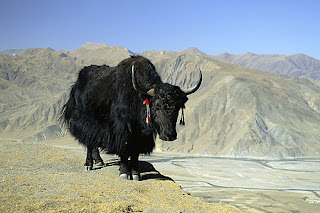Yak | The yak is a herd animal found
in the mountainous regions of central Asia. The yak tend to gather in
herds from 10 yaks to 100 yaks, most of which are female. There are only
a few male yaks per herd. Although there is a large domestic population
of yak, there are only a few wild yak remaining . The yak is still used
in many parts of central Asia, for pulling heavy farm machines and transporting large loads through the mountain passes.
The average male yak can grow to about 2meters tall, with the female yak being about 1/3 the size of the male yak. All yak have very long hair to keep them warm. The yak belongs to the same cow family as the Asian water buffalo, the African buffalo and the American bison.
However, the yak is slightly more like the American bison in appearance
as both the yak and the bison have long hair in order to withstand the
colder climates, the bison of the North American winters and the yak of
the mid-Asian mountains.
The yak breeds in the warmer months of September and after a gestation period of nine months the female yak gives birth to a single
yak calf. A female yak will occasionally give birth to twins but it is
very rare. Some female yak give birth to a calf almost every year but it
depends on the environment in which the yak lives and the yak
individual. Yak babies are completely independent by the time
that they are a year old and they are fully grown when they are between 7
and 8 years old. The average lifespan of a yak is about 20 years in the
wild and slightly longer when in captivity.
Like other species of cow, the yak is a herbivore and spends a great deal
of time on grassy plains in the mountains grazing on grasses, herbs and
wild flowers. In a similar way to other cow species the yak has more
than one stomach which the yak uses to successfully get all of the
nutrients out of the plants that it eats. The yak has firm, dense horns
which the yak uses to break through snow in order to get the plants that
are buried beneath it and the yak will also use it's horns in defence.
They have long shaggy hairthat covers their bodies that keep them warm
and dry.






No comments:
Post a Comment